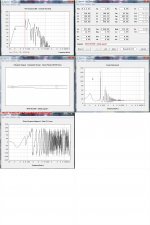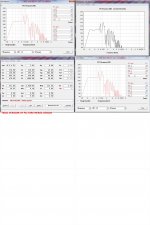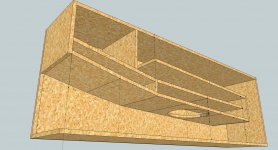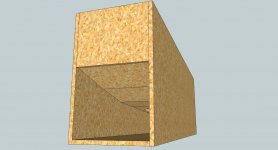Sorry Oliver, didn't see this added question to your post. I heard from Kees that exporting EXP files is a problem. In that case you can change and adjust the flares of the sections for convenience. Since a TH doesn't work like a 'real' horn it doesn't matter much. Chop it into minimal 6 parallel section and it would also work ;-)I'm assuming the EXP in all sections is on purpose?
Hi Djim,
Any particular reason this one is in 0.5 x Pi? Initially, I missed the TH1. I'm assuming the EXP in all sections is on purpose?
Regards,
Ja het word spannend.
Exiting
Hi Oliver,Would this driver not benefit from a slightly shorter horn, even if a little of the very bottom gets lost?
Kees had specific requests like, being able to reproduce the lowest organ note (16Hz) and all the way up to 70Hz. If his driver is able to cope the physical punishment, I can't answer, since I have no experience with Infinity drivers. Probably a lot will depend on how Kees is going to use his sub.
But we can't ask him since he seems, all of the sudden, very occupied in his workshop...
Hi All my livingroom is a workshop, happely I have no wife otherwise i had already the tapped horn landing in my neck.
Oke, I have follow the advise of Djim, I have removed the coil in hornresp and do use S4 and S5 also, now I have some less low end, but still the lowest note is there when needed, I do not punisch this sub it is for home theater use and music together with a little wideband horn. Tapped horn is now sensible for coils in it,s pad, so a big amp is needed, I do use one tapped horn and two (cheaper then fostex) Dayton PS180 horns (I need to simulate this BL horn for this speaker to see what combine does.).
I am not sticked on 70 hz perse, I can also use 50 or 60 hz, but the lows end now is also enough, now I have a box as a T-TQWT the same delay, 205 liters big, original was 289 liters. The infinity is very strong, has very stiff cone and heavy surround.
I get with al this testing afcourse more knowledge about speakers boxes, however I was good with TL and open baffles with martin sheets, but these are more predictable as a tapped horn or a T-TQWT.
Let me now what you think of these pictures, for me it looks good.
regards
Oke, I have follow the advise of Djim, I have removed the coil in hornresp and do use S4 and S5 also, now I have some less low end, but still the lowest note is there when needed, I do not punisch this sub it is for home theater use and music together with a little wideband horn. Tapped horn is now sensible for coils in it,s pad, so a big amp is needed, I do use one tapped horn and two (cheaper then fostex) Dayton PS180 horns (I need to simulate this BL horn for this speaker to see what combine does.).
I am not sticked on 70 hz perse, I can also use 50 or 60 hz, but the lows end now is also enough, now I have a box as a T-TQWT the same delay, 205 liters big, original was 289 liters. The infinity is very strong, has very stiff cone and heavy surround.
I get with al this testing afcourse more knowledge about speakers boxes, however I was good with TL and open baffles with martin sheets, but these are more predictable as a tapped horn or a T-TQWT.
Let me now what you think of these pictures, for me it looks good.
regards
Attachments
Hi kees52,
That one looks good, but you can improve on it by making it a bit larger. Especially at high power I think it would be better slightly larger. I'll attach a version that's a little larger, and I added a 3mH inductor back in series with Le. Just import the file into Hornresp.
Regards,
That one looks good, but you can improve on it by making it a bit larger. Especially at high power I think it would be better slightly larger. I'll attach a version that's a little larger, and I added a 3mH inductor back in series with Le. Just import the file into Hornresp.
Regards,
Attachments
Hi TB46
Just that inductor is what Djim not like if it is set in series with the woofer induction, Djim say it is better to do that in the filter wizzard.
This box is not for PA it is for home use, I think when I do 120 dB inside with 20 hz, I get a visit of the nabure six houses away in the same block of houses.
But I will look afcourse.
Oke I have done also some with coil in speaker pad but then trough filter wizzard, and looks better, fall off of yours I don,t like, but we get better and better with a not so easy speaker.
Tb this new one give also more low and high end so to speak.
Readers; don,t use this tapped horn for PA it is for home theatre use.
regards
kees
Just that inductor is what Djim not like if it is set in series with the woofer induction, Djim say it is better to do that in the filter wizzard.
This box is not for PA it is for home use, I think when I do 120 dB inside with 20 hz, I get a visit of the nabure six houses away in the same block of houses.
But I will look afcourse.
Oke I have done also some with coil in speaker pad but then trough filter wizzard, and looks better, fall off of yours I don,t like, but we get better and better with a not so easy speaker.
Tb this new one give also more low and high end so to speak.
Readers; don,t use this tapped horn for PA it is for home theatre use.
regards
kees
Attachments
Last edited:
Hi Djim,
Because it smoothens out the response in this case. As long as the value does not get too large. kees52 has described a method for building his own.
I find it easier to include an inductor in Le and to then use the Hornresp Wizard to arrive at the box dimensions.
In practice all this does probably not make any difference, somewhere along the line one has to build and measure.
Regards,
Because it smoothens out the response in this case. As long as the value does not get too large. kees52 has described a method for building his own.
I find it easier to include an inductor in Le and to then use the Hornresp Wizard to arrive at the box dimensions.
In practice all this does probably not make any difference, somewhere along the line one has to build and measure.
Regards,
Djim mention that the response in a home is aready very peaky and that a inductor is not important, I agree, but with simulation it is a nice graph with it.
I go make the box as soon as i can, I do first some more sims without a inductor and measurements with Holmimpulse after that.
Thank you al for al the learning stuff.
regards
kees
I go make the box as soon as i can, I do first some more sims without a inductor and measurements with Holmimpulse after that.
Thank you al for al the learning stuff.
regards
kees
Last edited:
Hi Kees and Oliver,
Kees, I'm not sure if those are my exact words ;-) but indeed, the less than 1dB improvement is probably even less in reality where peaks and dips are halved anyway. Simming the exact outcome of inductors is a little tricky since these simming-inductors are perfect in simulation and everything but perfect in reality. For that reason I mentioned to you to test it afterwards instead of designing with it.
Also, Oliver has covered the Re of the inductor within the Re of the driver which should give similar results like the wizzard.
Oliver, thanks for the explanation and I agree that reality only can tell if it is worth.
One question, do you think the Re of the inductor should be added to Re (driver) or Rg (amp output resistance)? I think the wizzard adds it to Re...
Kees, I'm not sure if those are my exact words ;-) but indeed, the less than 1dB improvement is probably even less in reality where peaks and dips are halved anyway. Simming the exact outcome of inductors is a little tricky since these simming-inductors are perfect in simulation and everything but perfect in reality. For that reason I mentioned to you to test it afterwards instead of designing with it.
Also, Oliver has covered the Re of the inductor within the Re of the driver which should give similar results like the wizzard.
Oliver, thanks for the explanation and I agree that reality only can tell if it is worth.
One question, do you think the Re of the inductor should be added to Re (driver) or Rg (amp output resistance)? I think the wizzard adds it to Re...
Last edited:
Hy Djim and Oliver
I do without the coil, this can always afterwards being implemented, for the time being I go now do practice, practice the folding, more important then the coil of sim.
You both thanks for the help, it was very helpful to me get into the speaker world the right way.
In picture you see a folding it is a test afcourse to get folding in my head (try also autocad lite), But soon I go start build the tapped horn and the T-TQWT after that, I need some speakers for eventually on a meeting with my hybrid amps.
Djin, Hornresp filter wizard can include a resistor in series with a coil, I do keep rg always 0, a good modern amp is very very low impedance, special ringemittor transistors, more then fets
but oke that is offtopic.. By the way if I do a coil in serie with speaker induction I get the same outcome the same with rg, so yes I think it is added then.
regards kees
I do without the coil, this can always afterwards being implemented, for the time being I go now do practice, practice the folding, more important then the coil of sim.
You both thanks for the help, it was very helpful to me get into the speaker world the right way.
In picture you see a folding it is a test afcourse to get folding in my head (try also autocad lite), But soon I go start build the tapped horn and the T-TQWT after that, I need some speakers for eventually on a meeting with my hybrid amps.
Djin, Hornresp filter wizard can include a resistor in series with a coil, I do keep rg always 0, a good modern amp is very very low impedance, special ringemittor transistors, more then fets
but oke that is offtopic.. By the way if I do a coil in serie with speaker induction I get the same outcome the same with rg, so yes I think it is added then.
regards kees
Attachments
Last edited:
Hi Djim,
Post #4137: "...do you think the Re of the inductor should be added to Re (driver) or Rg (amp output resistance)?.."
When I don't forget about it I add .05 Ohm for every mH to Rg, and .1 Ohm for cable resistance. I find this method useful to see what would happen if the inductance is higher at low frequencies than the standard data sheet value.
Regards,
Post #4137: "...do you think the Re of the inductor should be added to Re (driver) or Rg (amp output resistance)?.."
When I don't forget about it I add .05 Ohm for every mH to Rg, and .1 Ohm for cable resistance. I find this method useful to see what would happen if the inductance is higher at low frequencies than the standard data sheet value.
Regards,
Hi Djim,
Post #4137: "...do you think the Re of the inductor should be added to Re (driver) or Rg (amp output resistance)?.."
When I don't forget about it I add .05 Ohm for every mH to Rg, and .1 Ohm for cable resistance. I find this method useful to see what would happen if the inductance is higher at low frequencies than the standard data sheet value.
Regards,
Tapped horns are very sensitive for cable resistance, a T-TQWT is far more forgiving what resistance concerns, this because of the compression in tapped horns, a low qts woofer can better be used then to compnsate.
regards
kees
- Home
- Loudspeakers
- Subwoofers
- Collaborative Tapped horn project



